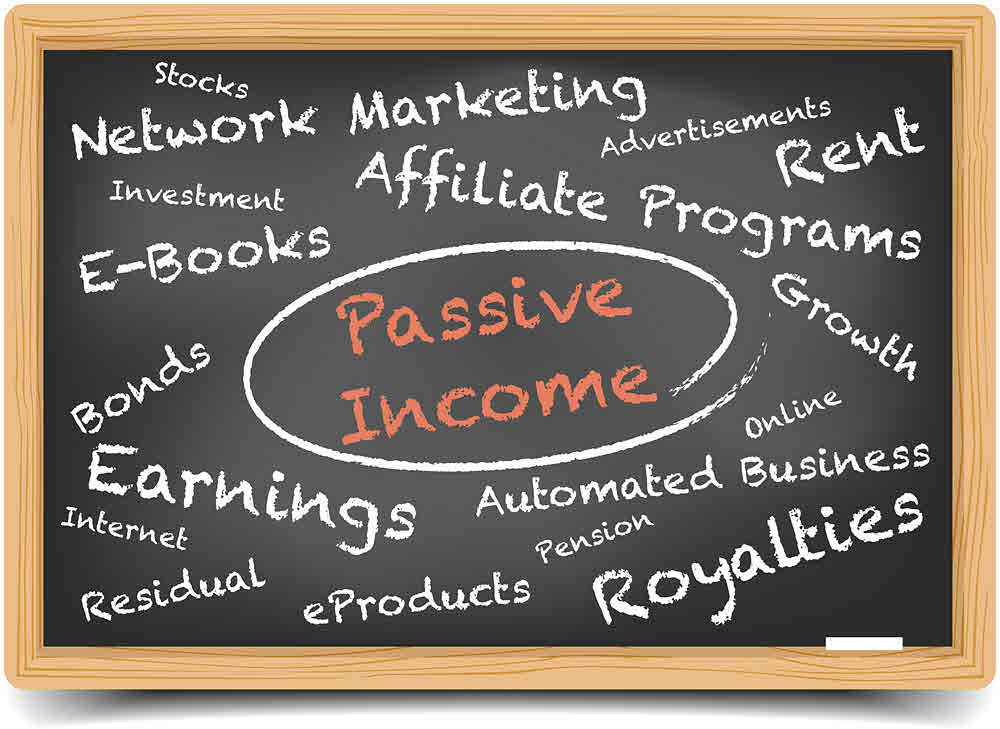Mastering Passive Income: A Comprehensive Guide to Financial Freedom
In a world where financial stability is the cornerstone of a secure future, passive income is a light of hope for individuals seeking financial freedom. Passive income, termed the “Holy Grail” of wealth creation, refers to money obtained with little effort on the recipient’s behalf. This can take many different forms, ranging from rental income and dividends to affiliate marketing and online companies.

Passive income is the financial lifeblood that flows in the absence of regular, active participation. It is the income generated by businesses that require an initial investment of time, money, or both, but generate revenue with minimal ongoing effort. Unlike traditional earned income, which demands continuous labor, passive income frees people from the time-for-money paradigm, allowing them to live a more emancipated and flexible lifestyle.
Importance of Passive Income for Financial Freedom
Many people’s ultimate objective is financial freedom, and passive income is a major player in this road. Beyond the usual nine-to-five grind, passive income offers a road to financial independence, allowing individuals the luxury of time and the freedom to shape their lives on their own terms. It acts as a safety net during economic downturns and retirement, encouraging resilience in the face of life’s unpredictability. Passive income is not just a supplement in the pursuit of financial freedom; it is a cornerstone that fortifies the structure of economic stability.
Overview of Different Passive Income Streams
Passive income is a complex gem that provides a variety of opportunities for people looking to diversify their cash streams. The landscape of passive income is large and varied, ranging from conventional real estate investments to current online companies. Rental income from real estate, dividends from equities, interest from loans, royalties from creative works, and the dynamic world of affiliate marketing and digital products are just a few of the alternatives available to people who want to master the art of passive income. This comprehensive guide will lead you through these paths, providing light on the complexities and nuances that define each one.
Begin this illuminating journey, where the key to financial freedom lies not in constant toil, but in recognizing and capitalizing on the promise of passive income. The sections that follow will unravel the fabric of passive income, providing insights, methods, and actionable activities to help you achieve long-term financial freedom.
Understanding Passive Income
Types of Passive Income
Dive into the ocean of passive income to discover a plethora of streams, each with its own currents and rewards.
- Rental Income: Rental income is a traditional pillar of passive income that entails owning real estate and leasing it to renters. Real estate investments, whether residential or commercial, provide a consistent cash flow. However, success in this field is dependent on rigorous market research, savvy property selection, and skilled property management.
- Dividend Income: Investing in dividend-paying companies provides shareholders with a consistent pay out, demonstrating the company’s profitability. Dividend income is a consistent source of income, particularly for long-term investors seeking to establish a stable portfolio. Investors can generate a steady source of passive income by carefully selecting dividend stocks.
- Interest Income: Interest income is generated by storing money in interest bearing instruments such as bonds or savings accounts. While low-risk, this type of passive income may produce lesser returns. Nonetheless, it provides a solid basis for conservative investors looking for a good mix of risk and profit.
- Royalties: Royalties from intellectual property—whether books, music, or inventions—provide an opportunity for perpetual profits for the creatively inclined. This type of passive income rewards those who contribute to the cultural and technological fabric by transforming their creations into long-term revenue streams.
- Affiliate Marketing: Affiliate marketing is a powerhouse in the domain of passive income in the digital era. Individuals can monetize their internet presence by marketing products or services and earning a commission on sales. The cornerstones of affiliate marketing success include selecting the proper items and categories, creating a loyal audience, and utilizing successful marketing methods.
- Online Courses and Digital Products: Through the creation and sale of online courses and digital products, the boom in online education and digital consumption has created a potential channel for passive income. Individuals can monetize their experience and knowledge by creating excellent material, whether in the form of eBooks, courses, or webinars.
Benefits of Passive Income
The appeal of passive income extends beyond the simple act of building wealth; it provides a slew of advantages that reshape the definition of financial success.
- Diversification of Income Sources: Depending only on a traditional employment for revenue is analogous to constructing a house on unsteady ground. Passive income, with its various streams, provides a solid foundation that protects individuals from work market volatility.
- Wealth Accumulation: Passive income functions as a multiplier of wealth. As streams build up and expand, so does one’s financial reservoir. This accumulation strengthens financial resilience and opens the door to investment opportunities that can increase wealth.
- Time Freedom: In contrast to the limits of a traditional employment, passive income frees up time. It allows people to choose their own schedules, pursue their passions, and enjoy life outside of the restrictions of a nine-to-five job.
- Flexibility: Passive income is not constrained by geography or time. Passive income continues to flow, offering financial security while allowing for a flexible lifestyle, whether you’re drinking coffee on a beach or navigating the urban jungle.
Understanding the subtleties of these passive income streams is critical to developing a customized strategy that corresponds with personal goals and preferences. The following parts will delve into the complexities of getting started, presenting a road map for making passive income dreams a reality.
Getting Started with Passive Income
Setting Financial Goals
Starting on the path to passive income requires a clear destination in mind. Setting attainable and measurable financial goals serves as a guidepost, directing your efforts and influencing your approach. Whether it’s meeting a certain monthly income objective or saving for future investments, well-defined goals serve as the foundation for your passive income endeavours.
Assessing Your Skills and Interests
Passive income opportunities are most satisfying when they are connected with your talents and hobbies. Conduct an in-depth self-evaluation to determine your strengths, expertise, and areas of interest. This introspection will not only guide you toward the most suited passive income streams, but it additionally fosters a sense of fulfilment in your endeavours.
Researching and Choosing the Right Passive Income Stream
The world of passive income is wide, and not every stream is created equal. Diligent research is the foundation of sound decision-making. Investigate the complexities of each prospective stream, evaluating the risks and rewards. Consider the initial investment, the time commitment, and the scalability. Whether it’s real estate, investments, or online companies, making an educated decision is the first step toward long-term passive income.
Legal and Tax Considerations

It’s critical to understand the legal and tax environments before plunging into the world of passive income. Various streams have different regulatory frameworks and tax effects. Working with financial specialists or tax advisors assures regulatory compliance and optimizes your financial strategy. Understanding the legal and tax implications not only protects your earnings but also lays the groundwork for long-term financial success.
You’re ready to take the plunge if you have a clear goal, self-awareness, and knowledge of the subtleties of your chosen passive income source. The parts that follow will delve into the specifics of real estate as a passive income stream and investment techniques that can pave the road for a prosperous financial future.
Real Estate as a Passive Income Stream
Investing in Rental Properties
Real estate is a cornerstone of passive income, providing tangible assets that can provide considerable returns. Investing in rental properties is a tried-and-true strategy, but success needs rigorous preparation and execution.
- Researching the Real Estate Market: Investigate the characteristics of the real estate market before purchasing property. Identify emerging locations, research property value trends, and understand rental demand in various neighbourhoods. A well-informed investor can make better strategic decisions.
- Property Selection Criteria: Choosing the appropriate property is a critical step. Consider considerations such as location, appreciation potential, and amenities. Understand the demographics of the target rental market in order to personalize your investment to potential tenants’ needs and preferences.
- Managing Rental Properties: Effective property management is the foundation of rental income. A proactive and structured attitude is required when dealing with maintenance, tenant relations, or managing laws. To streamline operations and maintain a consistent cash flow, many landlords hire professional property management services.
Real Estate Investment Trusts (REITs)
Real Estate Investment Trusts (REITs) are a potential option for investors seeking passive exposure to real estate without direct ownership. These investment entities pool funds from many investors in order to acquire and manage income-producing real estate.
- Benefits and Risks: REITs offer a diversified portfolio that reduces the risk of individual property ownership. They also provide liquidity by letting investors to purchase and sell stock on the stock exchange. However, REITs, like any other investment, are subject to risks such as market swings and economic downturns.
- How to Invest in REITs: REIT investing is accessible to both experienced and inexperienced investors. Choose between equity real estate investment trusts (REITs) that own and manage income-producing properties and mortgage REITs that invest in mortgages or mortgage-backed securities. Diversify your portfolio by choosing REITs that match your risk tolerance and investing objectives.
Understanding the complexities of real estate as a passive income source allows investors to confidently navigate the market. The following parts will delve into stock market investment techniques, digging into dividend stocks, index funds, and other routes that contribute to the mastery of passive income for financial freedom.
Investment Strategies for Passive Income
Stock Market Investments
The stock market provides a dynamic arena for passive income, with different techniques geared to different risk tolerances and financial goals.

- Dividend Stocks: Investing in dividend-paying companies is a time-tested way to generate passive income. Companies that pay out dividends to shareholders on a regular basis provide a consistent income stream. For a dependable and regular source of passive income, look for well-established companies with a history of steady dividend pay-outs.
- Index Funds: Index funds are an appealing option for a hands-off approach to stock market investing. These funds follow a certain market index, giving investors broad exposure to a diverse range of stocks. Index funds provide stability and a passive strategy, making them ideal for long-term development without the need for active management.
- Exchange-Traded Funds (ETFs): ETFs, like index funds, are a group of assets that trade on the stock market like individual equities. ETFs provide investors with flexibility by allowing them to purchase and sell throughout the trading day. ETFs provide a versatile tool for passive investors, with a wide range of alternatives covering numerous market sectors.
Peer-to-Peer Lending
Peer-to-peer lending systems in the digital era connect borrowers directly with lenders, providing an alternative source of passive income.
Platforms and Risks: These lending agreements are facilitated by platforms such as Prosper or LendingClub, which allow individuals to lend money to others in exchange for interest payments. While the potential rewards are appealing, it is critical to be mindful of the hazards connected with them, such as borrower defaults and economic downturns.
Maximizing Returns: Spread risk by diversifying your peer-to-peer lending portfolio. Research borrowers thoroughly and select platforms with effective risk-assessment processes. Consider reinvesting earned interest to increase your earnings over time.
Understanding the complexities of various investment techniques is the first step toward building a well-rounded portfolio. The following parts will look at ways to generate passive income online, such as affiliate marketing and digital product production, and will provide actionable insights and techniques for success.
Creating Passive Income Online
Affiliate Marketing
Affiliate marketing emerges as a powerful force in the digital realm, allowing individuals to monetize their online presence through clever relationships.
- Choosing Products and Niches: Choosing the correct items and niches is critical for affiliate marketing success. Find products that are relevant to the interests and demands of your target audience. Niche selection should achieve a balance between competition and demand, ensuring that your promotional efforts reach a receptive audience.
- Building an Audience: The key to successful affiliate marketing is an engaged audience. Create a community around your chosen niche by creating content, engaging in social media, and sending out emails. The importance of trust and authenticity cannot be overstated; your audience should regard you as a reputable source of suggestions.
- Strategies for Success: Promotion that is effective goes beyond simply endorsement. Create great content that educates and entertains while including affiliate links effortlessly. To maximize reach, use a variety of platforms such as blog posts, videos, and social media. Maintain an awareness of your audience’s preferences and adjust your approach accordingly.
Creating and Selling Digital Products

From eBooks and online courses to webinars, the digital arena provides a vast canvas for generating and selling things.
- eBooks: By using your skills, you can generate passive income by creating and selling eBooks. Choose themes that will resonate with your audience, while also assuring value and relevancy. Authors can access a global audience with platforms like Amazon Kindle, and marketing efforts can be automated for continued sales.
- Online Courses: Online courses are in high demand in the age of lifelong learning. Use platforms like Udemy or Teachable to share your knowledge. Create complete courses that cater to the demands of your audience, and once established, they can generate cash indefinitely.
- Webinars: Webinars, whether live or pre-recorded, give an engaging forum for showcasing skills and promoting items. Access fees or affiliate partnerships can be used to monetize. Webinars not only produce revenue, but they also promote a sense of community, which improves your online profile.
Mastering the art of passive revenue generation online necessitates a deliberate blend of content development, audience connection, and astute promotional strategies. The following parts will look at passive income from assets, such as dividend investing and fixed-income instruments, to provide a more diverse route to financial freedom.
Passive Income through Investments
Dividend Investing
Dividend investment is a consistent approach to passive income, since it aligns with the notion of earning while owning stock in trustworthy companies.
- Building a Dividend Portfolio: Creating a dividend portfolio entails carefully picking dividend-paying equities from a variety of industries. Companies having a track record of continuous dividend payments and a commitment to shareholder value should be prioritized. Diversify your portfolio to reduce the risks connected with specific stocks or industries.
- Reinvesting Dividends: In dividend investment, the power of compounding is highlighted. Dividend reinvestment enables exponential growth as earnings produce further returns. This method can considerably increase the size of your investment portfolio and the passive income it creates over time.
- Tax Considerations: It is critical to understand the tax implications of dividend income. Dividend tax rates may differ between jurisdictions. To maximize your after-tax gains, consider tax-efficient techniques such as holding dividend-paying equities in tax-advantaged accounts.
Bonds and Fixed-Income Investments
Bonds are reliable contributors to passive income in the world of fixed-income assets.
- Understanding Bonds: Bonds are loans provided to governments, municipalities, or corporations in exchange for periodic interest payments and the repayment of the principle amount when the bond matures. Bonds, while providing lower returns than stocks, provide stability and function as a complement to a diversified portfolio.
- Risks and Returns: Bonds, like any other investment, carry some hazards. Interest rate changes can have an impact on bond prices, lowering the overall return. Bonds, on the other hand, are generally regarded as safer than stocks, making them an appealing option for conservative investors seeking consistent income with lower volatility.
Diversifying your investment strategy between dividend stocks, bonds, and other fixed-income instruments helps to build a strong and balanced portfolio. The parts that follow will dig into the problems associated with passive income endeavors and present answers to typical traps, guaranteeing a smoother route to financial freedom.
Passive Income Challenges and Solutions

Common Pitfalls
While passive income is appealing, traversing this terrain is not without its difficulties. Recognizing typical hazards is the first step in risk mitigation.
- Lack of Patience: It takes time to build a substantial passive income. Impatience can lead to rash judgments that jeopardize financial stability. Develop a patient attitude, realizing that long-term success necessitates persistent effort and smart planning.
- Insufficient Research: Inadequate research can result in poor investment decisions. Understand the complexities of the passive income streams you’ve chosen, from market dynamics to legal considerations. Making educated decisions requires ongoing education.
- Overlooking Risks: All investments involve some level of risk. Overlooking or underestimating these risks might have serious financial consequences. Conduct thorough risk assessments and have contingency plans in place to deal with unknowns.
Overcoming Challenges
To overcome obstacles in the quest of passive income, a mix of adaptability, continual learning, and diversity is required.
- Continuous Learning: The financial scene is changing, and staying educated is critical. Adopt a mindset of continual learning, remaining up to date on industry trends, and adapting strategy to changing situations. Attend workshops, read industry publications, and participate in communities to broaden your expertise.
- Adaptive Strategies: Strategy flexibility is essential. What works today may need to be tweaked tomorrow. Be prepared to adjust to market changes, developing trends, and changing economic conditions. This adaptability supports the resilience of your passive income attempts.
- Diversification: Relying only on one passive income source can increase risks. Diversification distributes risk across many assets or investment types. A portfolio that is well-diversified is more resistant to market swings and economic downturns.
Navigating the hurdles of passive income necessitates a combination of tenacity, strategic thinking, and a dedication to continuous improvement. The parts that follow will reveal tactics for scaling and automating passive income, as well as a road map for increasing earnings and streamlining operations for long-term financial progress.
Scaling and Automating Passive Income
Scaling Your Passive Income Streams
Growing your passive income is similar to growing a successful business. Profits are re-invested, and your portfolio is intelligently diversified.
- Reinvesting Profits: Consider reinvesting profits when your passive income sources create returns to increase your earnings. Reinvestment fosters growth, whether it’s buying more dividend-paying stocks, expanding your real estate holdings, or starting new online businesses.
- Expanding Portfolio: Diversification is not only a risk-mitigation strategy, but it is also a path to growth. Investigate fresh prospects within your chosen passive income streams and think about expanding into complementary sectors. A well-rounded portfolio helps to ensure long-term growth and sustainability.
Automating Processes
Automation is the key to transforming passive income into a genuinely hands-free endeavour.
- Outsourcing: Delegate non-essential duties to simplify operations. Hiring a property management business can handle day-to-day obligations in real estate, but outsourcing jobs like content development or marketing can free up your time for strategic decision-making in internet ventures.
- Technology and Tools: Use technology to automate repetitive chores and acquire insights on your investments. Use portfolio management tools to track performance in the stock market, and email marketing platforms and analytics tools to optimize campaigns in online companies. Accept technology as a force multiplier in your passive income efforts.
Scaling and automating your passive income streams not only increases your cash rewards, but also frees up your time to focus on strategic decisions and explore new opportunities. The third portion will look into long-term wealth-building tactics, including asset preservation and reinvesting for compound growth, before finishing with a summary of key ideas and words of encouragement for readers seeking financial freedom through passive income.
Long-Term Wealth Building with Passive Income

Wealth Preservation Strategies
Building wealth entails more than just producing passive income; it takes careful planning to sustain and secure your financial foundation.
- Asset Protection: Use legal structures such as trusts or limited liability organizations (LLCs) to protect your assets. These structures can protect your assets from unforeseen obligations, adding an extra layer of security.
- Estate Planning: Make a thorough estate plan to enable the smooth transfer of assets to future generations. This includes drafting a will, establishing trusts, and dealing with tax issues. Estate planning protects your legacy while minimizing potential issues.
Reinvesting and Compound Growth
Profit reinvestment is critical for long-term growth and wealth accumulation.
- Reinvesting Profits Wisely: Instead of simply enjoying the advantages of your passive income, try strategically reinvesting. Whether it’s adding more income-generating assets or diversifying into new opportunities, reinvestment feeds the compounding effect, hastening your path to financial prosperity.
- Harnessing the Power of Compounding: Compounding is the secret element of wealth creation. Profits re-invested generate additional earnings, generating a snowball effect. Compounding returns can greatly magnify your initial investment over time, boosting your wealth-building journey to new heights.
Remember that each decision you make contributes to the fabric of your financial future as you traverse the intricate landscape of long-term wealth development using passive income. The section that follows will highlight major issues mentioned in this thorough guide and offer words of encouragement and motivation to readers who are commencing on their path to financial freedom through passive income mastery.
Conclusion
Recap of Key Points
In this comprehensive article, we’ve covered the diverse world of passive income, from comprehending its numerous forms to practical measures for getting started and long-term success techniques. Key takeaways include diversifying income sources, the benefits of passive income such as time flexibility and wealth growth, and navigating hurdles through continual learning and adaptive tactics. We went into specific passive income streams, such as real estate investments, stock market tactics, and web ventures. The significance of scaling and automating processes, as well as asset preservation measures and the transformative impact of reinvesting for compound development, were underlined.
Encouragement and Motivation for Readers
Starting on the path to financial independence with passive income is a worthy goal. Remember that success is the result of informed decisions, adaptability, and perseverance as you travel this route. There will always be obstacles, but each one will provide an opportunity for growth. Maintain your commitment to constant learning, recognize the power of compounding, and be willing to diversify your portfolio. Whether you’re interested in real estate, stocks, or online companies, the key is to get started, learn, adapt, and persevere. Your road to mastering passive income is a revolutionary trip toward a life of richness, freedom, and lasting riches.
This thorough guide covers all areas of passive income, offering readers with actionable ideas and solutions for financial independence. May your efforts bear fruit, and may mastery of passive income be the key to unlocking the doors to long-term wealth.

